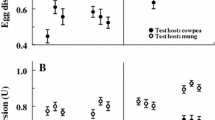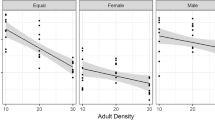Summary
Populations of the seed beetle Callosobruchus maculatus differ genetically in several traits that mediate intraspecific competition. This study examined competitive interactions between larvae from two strains that differed in their propensity to oviposit on occupied hosts. In a strain (S) where females avoided laying >1 egg/seed, larvae were highly competitive; if two larvae entered a small host simultaneously, only one adult emerged. In a strain (I) whose females were “sloppier” in their egg-laying decisions, more than half of the seeds bearing two larvae yielded two adults. If seeds contained one larva from each strain, only one adult emerged per seed, and 70% of these adults belonged to the more competitive S strain. A larva's probability of emergence could be increased if it entered the seed before its competitor. A two-day headstart was needed merely for I larvae to compete equally with S larvae. Competition also affected development time and adult weight, but its effect was highly strain- and sex-specific. Adult life-history traits also differed substantially between strains. Compared to I beetles, S beetles exhibited decreased longevity, lower fecundity, a truncated period of oviposition, and larger egg and body size. Fecundity was linearly related to body size in the I strain, but was largely independent of size in the S strain. When faced with a shortage of hosts, S females (whose progeny are highly competitive) “withheld” eggs and died without depositing 40% of their lifetime supply. In contrast, the fecundity of I females was independent of seed availability. Comparisons with previous studies suggest that both highly uniform egg-laying and strong interference among larvae may be a consequence of chronic association with a relatively small host. Results from the larval competition experiments were used as parameter estimates for a simple, game-theoretic model that postulates interference vs. exploitative strategies. Fitness comparisons suggest that a strategy employing interference competition cannot be invaded by a more exploitative form of competition in a small host.
Similar content being viewed by others
References
Bellows TS Jr (1982) Analytical models for laboratory populations of Callosobruchus chinensis and C. maculatus (Coleoptera, Bruchidae). J Anim Ecol 51:263–287
Bierbaum TJ, Mueller LD, Ayala FJ (1989) Density-dependent evolution of life-history traits in Drosophila melanogaster. Evolution 43:383–392
Boyce MS (1984) Restitution of r- and K-selection as a model of density-dependent natural selection. Ann Rev Ecol Syst 15:427–447
Bradshaw WE, Holzapfel CM (1989) Life-historical consequences of density-dependent selection in the pitcherplant mosquito, Wyeomyia smithii. Am Natur 133:869–887
Case TJ, Gilpin M (1974) Interference competition and niche theory. Proc Natl Acad Sci 71:3073–3077
Credland PF, Dick KM, Wright AW (1986) Relationships between larval density, adult size and egg production in the cowpea seed beetle, Callosobruchus maculatus. Ecol Entomol 11:41–50
Credland PF, Dick KM (1987) Food consumption by larvae of three strains of Callosobruchus maculatus (Coleoptera: Bruchidae). J Stored Prod Res 23:31–40
Credland PF, Wright AW (1989) Factors affecting female fecundity in the cowpea seed beetle, Callosobruchus maculatus (Coleoptera: Bruchidae). J Stored Prod Res 25:125–136
Dick KM, Credland PF (1984) Egg production and development of three strains of Callosobruchus maculatus (F.)(Coleoptera: Bruchidae). J Stored Prod Res 20:221–227
Fujii K (1968) Studies on interspecies competition between the azuki bean weevil and the southern cowpea weevil. III. Some characteristics of strains of two species. Res Popul Ecol 10:87–98
Giga DP, Smith RH (1987) Egg production and development of Callosobruchus rhodesianus (Pic) and Callosobruchus maculatus (F.) (Coleoptera: Bruchidae) on severalcommodities at two different temperatures. J Stored Prod Res 23:9–15
Gill DE (1974) Intrinsic rate of increase, saturation density, and competitive ability. II. The evolution of competitive ability. Am Natur 108:103–116
Godfray HCJ (1987) The evolution of clutch size in parasitic wasps. Am Natur 129:221–233
Haines CP (1989) Observations on Callosobruchus analis (F.) in Indonesia, including a key to storage Callosobruchus spp. (Col., Bruchidae). J Stored Prod Res 25:9–16
Hairston NG Jr, Walton WE (1986) Rapid evolution of a life history trait. Proc Natl Acad Sci 83:4831–4833
Messina FJ (1990) Alternative life-histories in Callosobruchus maculatus: environmental and genetic bases. In: Fujii K, Gatehouse AMR, Johnson CD, Mitchell R, Yoshida Y (eds) Bruchids and legumes: economics, ecology and coevolution, Kluwer Academic. Dordrecht, pp 303–315
Messina FJ, Mitchell R (1989) Intraspecific variation in the egg-spacing behavior of the seed beetle Callosobruchus maculatus. J Insect Behav 2:727–742
Messina FJ, Renwick JAA (1985a) Dispersal polymorphism of Callosobruchus maculatus, (Coleoptera: Bruchidae): variation among populations in response to crowding. Ann Entomol Soc Am 78:201–206
Messina FJ, Renwick JAA (1985b) Ability of ovipositing seed beetles to discriminate between seeds with differing egg loads. Ecol Entomol 10:225–230
Mitchell R (1975) The evolution of oviposition tactics in the bean weevil, Callosobruchus maculatus (F.). Ecology 56:696–702
Mitchell R (1983) Effects of host-plant variability on the fitness of sedentary herbivorous insects. In: Denno RF, McClure MS (eds) Variable Plants and Herbivores in Natural and Managed Systems. Academic Press, New York, pp 343–370
Mitchell R (1990) Behavioral ecology of Callosobruchus maculatus. In: Fujii K, Gatehouse AMR, Johnson CD, Mitchell R, Yoshida Y (eds) Bruchids and legumes: economics, ecology and coevolution. Kluwer Academic, Dordrecht, pp 317–330
Mousseau TA, Roff DA (1989) Adaptation to seasonality in a cricket: patterns of phenotypic and genotypic variation in body size and diapause expression along a cline in season length. Evolution 43:1483–1496
Partridge L, Harvey PH (1988) The ecological context of life history evolution. Science 241:1449–1455
Reznick D, Endler JA (1982) The impact of predation on life history evolution in Trinidadian guppies (Poecilia reticulata). Evolution 36:160–177
Sibly RM, Calow P (1985) Classification of habitats by selection pressures: a synthesis of life cycle and r/K theory. In: Sibly RM, Smith RH (eds) Behavioral Ecology: Ecological Consequences of Adaptive Behavior. Blackwell Scientific Publications Oxford, pp 75–90
Smith RH (1990) Adaptations of Callosobruchus species to competition. In: Fujii K, Gatehouse AMR, Johnson CD, Mitchell R, Yoshida Y (eds) Bruchids and legumes: economics, ecology and coevolution, Kluwer Academic, Dordrecht, pp 351–360
Smith RH, Lessells CM (1985) Oviposition, ovicide and larval competition in granivorous insects. In: Sibly RM, Smith RH (eds) Behavioural Ecology: Ecological Consequences of Adaptive Behavior. Blackwell Scientific Publications, Oxford, pp 423–448
Sokal RR, Rohlf FJ (1981) Biometry, 2nd Ed, W.H. Freeman, San Francisco
Southgate BJ (1984) Observations on the larval emergence in Callosobruchus chinensis (Coleoptera: Bruchidae). Entomol Gen 9:177–180
Spence JR (1989) The habitat templet and life history strategies of pond skaters (Heteroptera: Gerridae): reproductive potential, phenology, and wing dimorphism. Can J Zool 67:2432–2447
Stearns SC (1977) The evolution of life-history traits: a critique of the theory and a review of the data. Ann Rev Ecol Syst 8:145–171
Sulzbach DS (1980) Selection for competitive ability: negative results in Drosophila. Evolution 34:431–436
Thanthianga C, Mitchell R (1987) Vibrations mediate prudent resource exploitation by competing larvae of the bruchid bean weevil Callosobruchus maculatus. Entomol Exp Appl 44:15–21
Toquenaga Y (1990) The mechanisms of contest and scramble competition in bruchid species. In: Fujii K, Gatehouse AMR, Johnson CD, Mitchell R, Yoshida Y (eds) Bruchids and legumes: economics, ecology and coevolution, Kluwer Academic, Dordrecht, pp 341–349
Umeya K, Kato T, Kocha T (1975) Studies on the comparative ecology of bean weevils. VI. Intraspecific larval competition in Callosobruchus analis (F.). Jap J Appl Entomol Zool 19:47–53
Wilkinson L (1988) SYSTAT: The System for Statistics. SYSTAT, Inc. Evanston, Illinois
Zirkle DF, Dawson PS, Lavie B (1988) An experimental analysis of the genetic relationships among life-history traits and emigration behavior in Tribolium castaneum. Oikos 53:391–397
Author information
Authors and Affiliations
Rights and permissions
About this article
Cite this article
Messina, F.J. Life-history variation in a seed beetle: adult egg-laying vs. larval competitive ability. Oecologia 85, 447–455 (1991). https://doi.org/10.1007/BF00320624
Received:
Accepted:
Issue Date:
DOI: https://doi.org/10.1007/BF00320624




